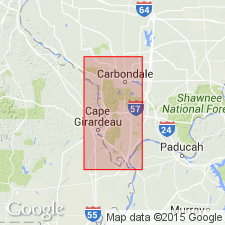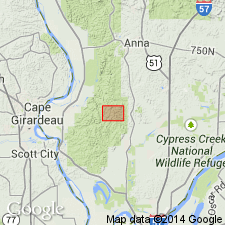
- Usage in publication:
-
- Clear Creek limestone
- Modifications:
-
- Named
- Dominant lithology:
-
- Limestone
- AAPG geologic province:
-
- Illinois basin
Summary:
Named for Clear Creek, Union Co., southwestern IL. Occurs in Jackson, Union, and Alexander Cos. Consists of 300 ft of yellowish-gray, thin-bedded, siliceous limestones underlain by 10 to 25 ft of mottled limestones with, locally at base, 4 ft of dark-bluish-gray, fossiliferous, coarse-textured limestone. Thickness of unit ranges from 250 to 350 ft. Overlies Niagara limestone; underlies Oriskany sandstone. Age is lower Helderberg and Oriskany.
Source: GNU records (USGS DDS-6; Reston GNULEX).

- Usage in publication:
-
- Clear Creek Chert
- Modifications:
-
- Overview
- AAPG geologic province:
-
- Illinois basin
Summary:
Unit is exposed in a north-trending belt, 50 km long, extending from west of Tamms in Alexander Co. to northwesternmost Union Co. In the area west of Elco, a thickness of 350 is estimated. In the area southwest of Jonesboro, where the Backbone Limestone is absent, the Clear Creek Chert overlies the Grassy Knob Chert, but the contact is not easily identifiable. Underlies the Dutch Creek Sandstone Member of the Grand Tower Limestone. Report contains several described sections of unit. Age is Early Devonian.
Source: GNU records (USGS DDS-6; Reston GNULEX).
For more information, please contact Nancy Stamm, Geologic Names Committee Secretary.
Asterisk (*) indicates published by U.S. Geological Survey authors.
"No current usage" (†) implies that a name has been abandoned or has fallen into disuse. Former usage and, if known, replacement name given in parentheses ( ).
Slash (/) indicates name conflicts with nomenclatural guidelines (CSN, 1933; ACSN, 1961, 1970; NACSN, 1983, 2005, 2021). May be explained within brackets ([ ]).

